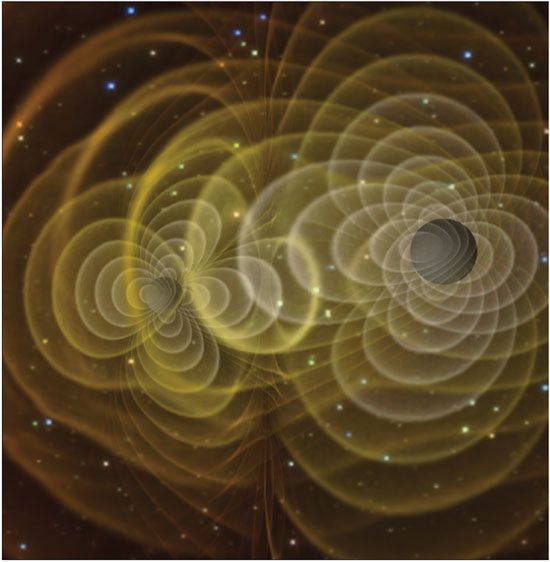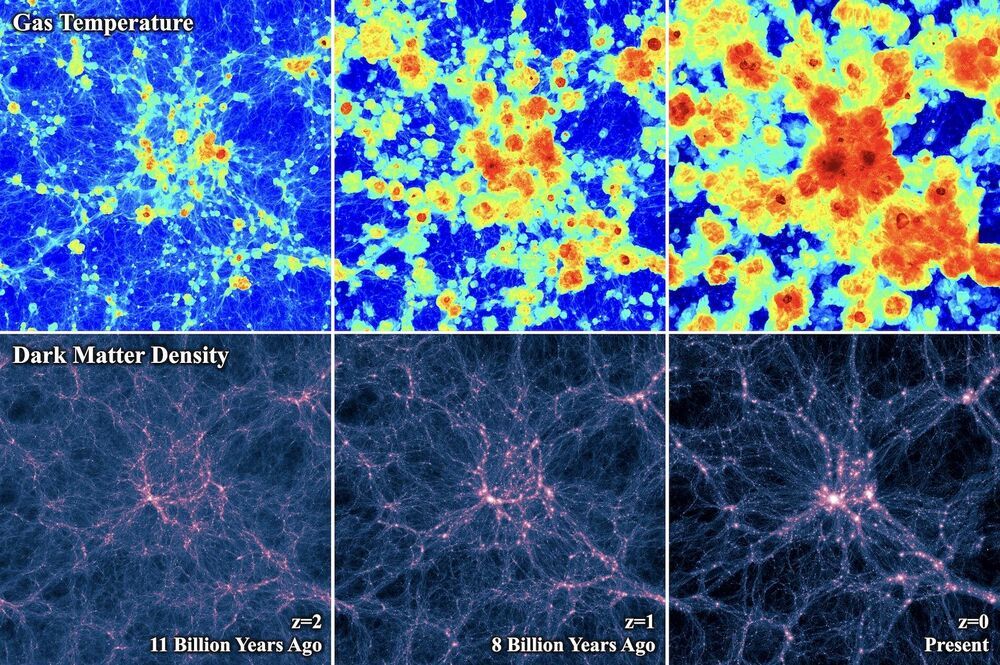O,.o this reveals the hertz of the spacetime continuum: 3.
In the biggest events in the universe, massive black holes collide with a chirp and a ring. Physicists are finding ways to listen in.


An expert on massive stars, Massey has been studying our nearest grand spiral neighbor, the Andromeda Galaxy for decades now. Andromeda is a cornerstone of almost everything we now know about astronomy — from the first recognition that the cosmos is made up of individual galaxies to the discovery of the universe’s still unexplained dark matter. Please join us as we chat about this beautiful and beguiling galactic neighbor.

In images from the Hubble Space Telescope, scientists have spotted an entirely new phenomenon. Reaching tens of thousands of light-years into the void of space, vast shadows stretch from the centre of the galaxy IC 5063, as though something is blocking the bright light from therein.
You’ve probably seen something very like it before – bright beams from the Sun when it’s just below the horizon and clouds or mountains only partially block its light, known as crepuscular rays. According to astronomers, the shadows from IC 5063 could be something very similar. They’re just a whole lot bigger – at least 36,000 light-years in each direction.
IC 5063, a galaxy 156 million light-years away, is a Seyfert galaxy. This means it has an active nucleus; the supermassive black hole at its centre is busily guzzling down material from a dense accretion disc and torus of dust and gas around it.

Johns Hopkins University study of 10 billion years of microwaves reveals a warming predicted by dark matter theory.
Who says you can’t get hotter with age?
Researchers from Johns Hopkins University and other institutions have found that, on average, the temperature of galaxy clusters today is 4 million degrees Fahrenheit. That is 10 times hotter than 10 billion years ago, and four times hotter than the Sun’s outermost atmosphere called the corona. The findings are published in the Astrophysical Journal.

Some of the greatest medical discoveries of the 20th century came from physicists who switched careers and became biologists. Francis Crick, who won the 1962 Nobel Prize in Physiology and helped identify the structure of DNA, started his career as a physicist, as did Leo Szilard who conceived the nuclear chain reaction in 1933, writing the letter for Albert Einstein’s signature that resulted in the Manhattan Project that built the atomic bomb, but spent the last decades of his life doing pioneering work in biology, including the first cloning of a human cell.
Today, a group of world-renowned researchers at the Perimeter Institute for Theoretical Physics with expertise from cosmology to quantum gravity are using physics to help fight the COVID-19 pandemic.

This is the episode for anyone who’s interested in learning more about our grand spiral neighbor, the Andromeda Galaxy. Join my guest Lowell Observatory, astronomer Phil Massey as we discuss how our beguiling behemoth of a neighbor helped shape contemporary astronomy.
First cataloged by Al Sufi as a mere optical smudge high in the winter sky, the Andromeda Galaxy has lately been a cornerstone of everything we know about contemporary astronomy and the cosmos as a whole. Join Lowell Observatory astronomer Philip Massey as he outlines how this grand spiral neighbor changed what we know about cosmology. And if you happen to be in the Northern hemisphere, by the end of the episode, you may be ready to try and spot the galaxy with just your naked eyes.

Calculations show how theoretical ‘axionic strings’ could create odd behavior if produced in exotic materials in the lab.
A hypothetical particle that could solve one of the biggest puzzles in cosmology just got a little less mysterious. A RIKEN physicist and two colleagues have revealed the mathematical underpinnings that could explain how so-called axions might generate string-like entities that create a strange voltage in lab materials.
Axions were first proposed in the 1970s by physicists studying the theory of quantum chromodynamics, which describes how some elementary particles are held together within the atomic nucleus. The trouble was that this theory predicted some bizarre properties for known particles that are not observed. To fix this, physicists posited a new particle—later dubbed the axion, after a brand of laundry detergent, because it helped clean up a mess in the theory.

The last decade has been marked by a series of remarkable discoveries identifying how the universe is composed. It is understood that the mysterious substance dark matter makes up 85% of the matter in the universe. Observable matter in the universe consists of ionized particles. Thus, a profound understanding of ionized matter and its interaction with light, could lead to a deeper understanding of the relationships at play that formed the universe. While ionized matter, or plasma, is relatively easy to generate in the lab, studying it is extremely challenging as methods that can capture ionization states and density are virtually non-existant.
In a new paper published in Light Science & Application, a team of scientists has succeeded in directly observing the formation and interaction of highly ionized krypton plasma using femtosecond coherent ultraviolet light and a novel four-dimensional model.

The CERN in Geneva has become a sink for public money.
At the same time there’s a lack of funding in other research areas, that would be much more urgent!
In this video I explain why building a next larger particle collider will most likely not tell us anything about dark matter and why, therefore, claims by prominent particle physicists that dark matter would be a “guaranteed result” are misleading.
The piece that I quote in the beginning is this:
https://www.nature.com/articles/s41567-020-01054-6
The other quotes (and more) with sources are collected here:
http://backreaction.blogspot.com/2018/12/how-lhc-may-spell-end-of-particle.html
You can help finance my videos by donating here:
https://www.paypal.com/cgi-bin/webscr?cmd=_s-xclick&hosted_button_id=QZ6QCBQYUMJEG&source=url

“We were in the middle of observing one night, with a new spectrograph that we had recently built, when we received a message from our colleagues about a peculiar object composed of a nebulous gas expanding rapidly away from a central star,” said Princeton University astronomer Guðmundur Stefánsson, a member of the team that discovered a mysterious object in 2004 using NASA’s space-based Galaxy Evolution Explorer (GALEX). “How did it form? What are the properties of the central star? We were immediately excited to help solve the mystery!”
A 16-Year-Old Mystery
NASA announced today that it has solved the 16-year-old mystery of the object –similar in size that of a supernova remnant–unlike any they’d seen before in our Milky Way galaxy: a large, faint blue cloud of gas in space with a living star at its center. Subsequent observations revealed a thick ring structure within it, leading to the object being named the Blue Ring Nebula.